Ostara strawberry variety
Ostara is a remontant variety of garden strawberry (strawberry) for universal use. Bred by Dutch PRI breeders in the 70s by crossing Redgauntlet and Macherauches. It is appreciated for its high yield, unpretentious care and undemanding to soil and climate, as well as for the excellent taste of berries. Strawberries are suitable for cultivation on a personal plot for personal consumption, but they are not suitable for cultivation on a commercial scale due to the poor transportability and keeping quality of berries. Over the years of its existence, Ostara managed to collect many rather contradictory reviews about herself, so we will figure out what she is good at and why she did not become a favorite among other remontant varieties.
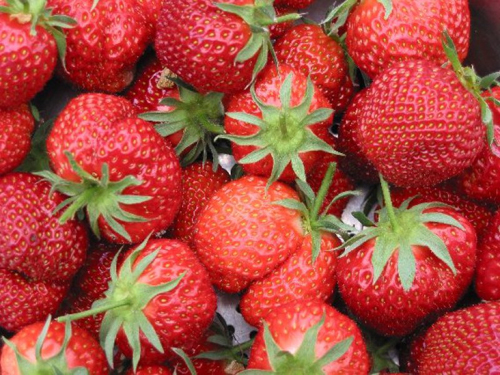
The plant is medium in size, up to 30 cm in height, medium-leafy, very compact, has a spherical shape. The absorption is moderate, depending on the intensity of use, it can be reduced to extremely minimal. A characteristic feature of the variety is that it bears fruit both on the mother bush and on unrooted rosettes, however, it will not be possible to get a good harvest from the mustache, but we will talk about this later. Leaves are medium in size, dark green in color. The petiole is pubescent. The flowers are white, bisexual, with well-developed anthers. Ostara has very high quality pollen, making it one of the best pollinators for other species. Peduncles of medium length, located at the level of the leaves, sink to the ground under the weight of the harvest. Strawberries form quite a few peduncles, on which a large number of fruits are tied, which ensures good yields.
The berries themselves are of medium size, gardeners even say that, in comparison with other remontants, Ostar bears fruit in trifles, but in large quantities. Fruits are broadly conical, tending to round, without a neck. The skin is bright red, shiny. Achenes are yellow, can acquire a red tint, are deeply pressed into the pulp, which makes strawberries unsuitable for transportation. The pulp is moderately firm, with a very delicate texture, very juicy and aromatic. Ostara's taste is excellent - the berries are very sweet, but not without a delicate sourness, they very much resemble real strawberries, will not leave indifferent lovers of the classic strawberry taste. By the way, it is precisely thanks to her taste that our heroine often retains her place on the site, because in her other characteristics she is often inferior to other remontant varieties.
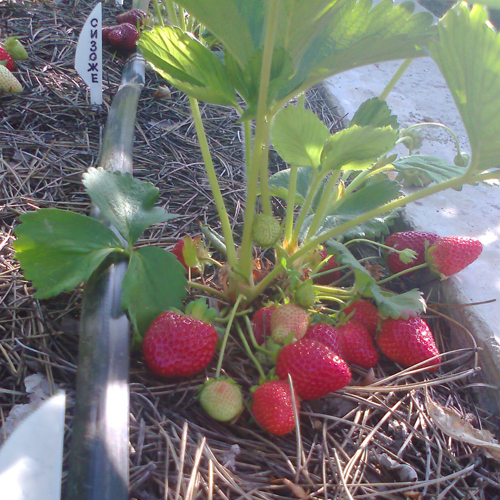
The berries are universal in use, excellent fresh, excellent for processing into jams, preserves, but they are not particularly suitable for freezing due to their too soft and juicy pulp. For the same reason, strawberries do not tolerate transportation very well, and they are also not very well stored, and even with careless collection, they can deform and begin to secrete juice. Thus, it is categorically unsuitable for growing for the purpose of selling fresh produce to the Ostar market, no matter what nurseries write in the description of the seedlings. According to gardeners, the berries are sometimes difficult to bring in their original form even to the mouth, let alone transport them to the point of sale. For business, it is better to take a closer look at solid-fruited remontant varieties.
The average weight of fruits is 15-20 grams, even less with moderate agricultural practices. The strawberry begins to bear fruit in July and ends in late autumn, in November. Moreover, it is in the autumn wave of fruiting that the largest berries are observed, although some sources indicate that large specimens are more characteristic of the first waves. On foreign sites, you can often find a statement that Ostara also bears fruit in the spring, moreover, twice. Most likely, this is true for growing in protected ground, in greenhouses, where plants can bring crops almost all year round.The yield of the variety is high, from one bush it is possible to collect about 1 kg of berries with moderate agricultural technology, with intensive indicators it can increase to 2 kg per plant. Of course, to achieve such high results, it is necessary to provide the strawberries with abundant regular nutrition, as well as truly ideal care. Gardeners may well count on 700-900 grams of fruit per bush, provided that agricultural technology is not of the highest quality.
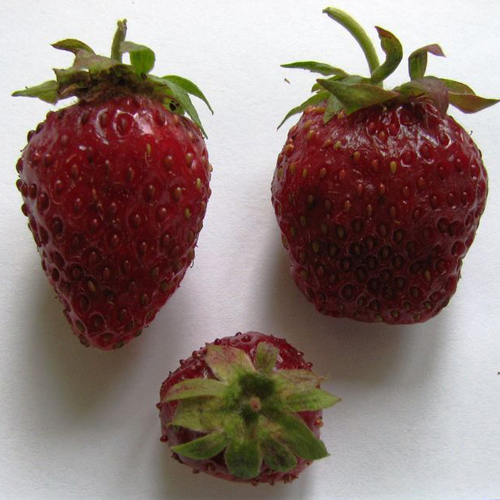
Ostara is not famous for its excellent immunity, it is quite sensitive to diseases of the root system, and berries are prone to be affected by gray rot. On the other hand, according to gardeners' reviews, this nuance does not cause much trouble, our heroine is sick no more often than other varieties on the site. But, of course, timely prevention is urgently needed. Strawberries have good winter hardiness, winters well even without shelter, although it is still worth playing it safe. In the northern regions, covering materials are especially relevant, since, after all, the variety is Dutch and is clearly not adapted to the harsh cold climate. The drought resistance and heat resistance of the variety is also at a high level, in the hottest periods the plants feel quite comfortable, however, the berries in this case can become very soft.
In agricultural technology, Ostara is very simple, does not require special attention to itself, it can even be safely recommended to beginner gardeners. Unlike many other sissy varieties, our heroine can forgive you for mistakes in agricultural technology, but the better you take care of the plantings, the more they will delight you. Strawberries are not particularly demanding on soils, they can be grown on a wide variety of soils, but it is very important that they are fertile. Thus, before planting, the site must be thoroughly prepared and fertilized. Subsequently, it is also necessary to regularly feed the plants if you want to get bountiful harvests. Still, the species is remontant, it bears fruit for a very long time, so it needs good nutrition, otherwise a frank trifle will form on the bushes.
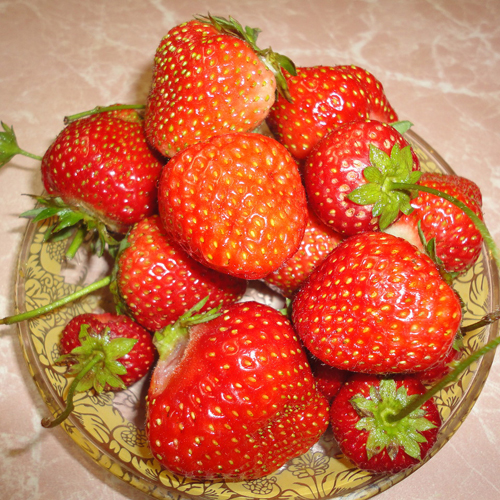
By the way about that. Most gardeners complain about the very small size of the berries. Indeed, Ostara does not differ in giant fruits, but it cannot be called completely small-fruited either. In fact, the size and weight of strawberries are highly dependent on the intensity of agricultural practices. As already mentioned, the plant forms a large number of multi-edged peduncles, and it needs abundant nutrition in order to grow many large fruits. Thus, do not skimp on fertilizers; foliar dressing is also relevant.
There is one more point related to the size of the Ostara berries. Since the variety also bears fruit on unrooted outlets, many gardeners are very happy about this, neglecting the timely removal of the mustache. This is a very wrong decision - you will not get a good harvest from the rosettes, except perhaps next year, when they have already turned into an independent plant. It is much more expedient to remove the extra mustache so that the uterine bush spends its energy not on them, but on the fruits. In general, it is better to divide the planting of strawberries - in one area the plants "work" for the harvest, in the other - for reproduction.
Of the remaining agrotechnical nuances, only a couple of points should be mentioned. Firstly, the variety does not like waterlogging, so control the amount of watering. By the way, in rainy seasons this can become a problem, and during such periods it is necessary to strengthen the protection of plants from fungal diseases. Secondly, it is extremely important to update the plantings in a timely manner. Ostara does not shine with large fruits anyway, and if you do not rejuvenate the plantation, then there will be no limit to disappointment. It is advisable to use plants for no more than one year, maximum two.The variety is remontant, it quickly develops its entire resource, so there is no need to wait for the impossible from three or four-year-old bushes.
Let's make some small conclusions. This strawberry is very good for growing in the garden for personal consumption - it has excellent taste, unpretentious care, does not require the creation of ideal conditions. Also a big plus is the possibility of cultivation in different climatic latitudes. Well, for commercial purposes, Ostara is not very attractive, so you should immediately look for an alternative. Among many other popular remontant varieties, our heroine especially stands out for her soft fruits with excellent taste, so she can be called special to some extent. If you are not chasing new breeding products that bear fruit the size of an apple, but want something tastier, moreover, so that the yield is decent, then Ostara is a very good option.




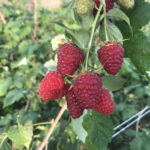
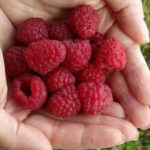



I really like Ostara - the berries are small (in my opinion), but there are so many of them that it is enough to eat and freeze. For a remontant variety, the berries have a very good taste - they are juicy, not solid, however, not transportable (they must be eaten or processed immediately). Like all remontant varieties, Ostara is very fond of water - without abundant watering, berry setting stops, but you have to be careful with watering, since the culture is very "painful" and with high humidity it picks up all kinds of diseases. Good fruiting has one more unpleasant side - the more berries, the less mustache (once it was necessary to rejuvenate the planting, but there was no mustache, I had to plant it with "horns").